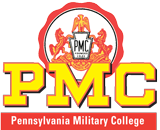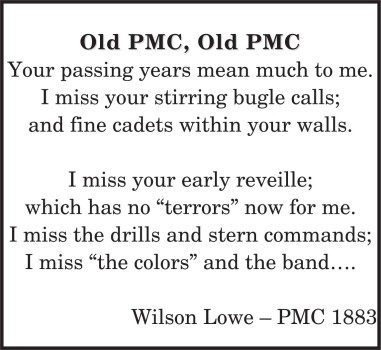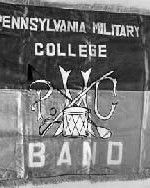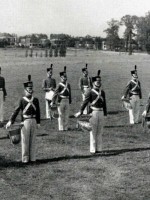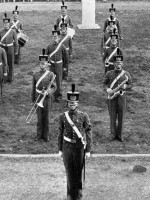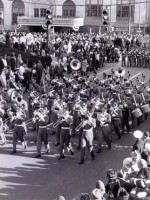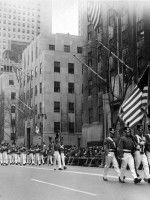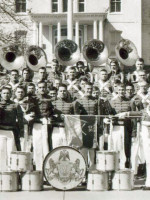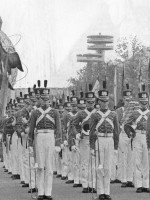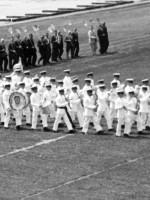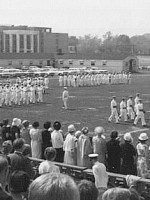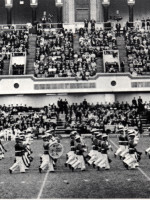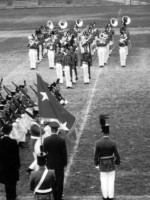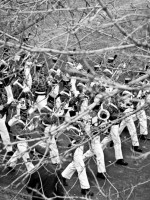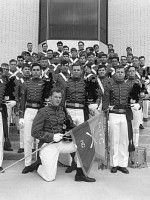The early years of music at PMC and its predecessor institutions featured various student musical organizations, including fife, bugle and drum units, concert bands and orchestras. There were even string bands featuring mandolins, guitars and banjos. Over the years, various dance bands with names like “The Grenadiers” and “The Militaires” also performed, patterning their style after the big bands of their eras, including Glenn Miller and Woody Herman. Distinguished Alumni Burt Mustin – Class of 1903 (trombone) and Bill Stern – Class of 1930 (saxophone) were proud PMC musicians.
Drums and bugles, of course, always played a major role in campus life as Cadets went about their daily activities with buglers announcing each event and the beat of the drums marching them to the mess hall. When Theodore Hyatt founded the Delaware Military Academy in 1858-1859, among the faculty was Richard Triggs with the title of Professor of Vocal and Instrumental Music. In 1864, the legendary Professor John Robson Sweney came to Pennsylvania Military Academy and re-organized the Drum Corps group. Sweney had been a bandmaster for the Union Army during the Civil War, having led the Third Regiment Delaware Volunteers Band. Under his leadership, that band had paraded before President Lincoln. Sweney authored many original musical compositions over the years, including many famous Christian hymns, some of which are still well known today. Bluegrass singer Alison Krauss has even recorded Sweney’s music. Sweney also wrote some contemporary pieces like “Colonel Hyatt’s Polka,” as well as “March to PMA.” John Wanamaker, founder of the first department store in Philadelphia and Chair of the Board of Trustees, was a friend of Sweney and spoke at his funeral.
In the 1903 yearbook, the PMC Band is listed as a musical organization with twenty members under the direction of E.W. Hyatt. In 1935, Professor/Major John Norris Robinson ’84, starting with fourteen cadet musicians, launched the modern day PMC Marching Band that played at formations, honor guards and parades. Robinson had previously directed the 198th Coast Artillery Band. World War II temporarily reduced its ranks but drums and bugles remained on campus. After the war, the Band soon grew strong again and was even appearing on local area radio and TV programs in the late ‘40s and ‘50’s.
Music Director Dr. Carl Wisneski came to PMC in 1955 and molded the Band musically until circa 1970. The PMC Band reached its largest size in the 1960s when the Band often fielded 60-80 musicians marching eight men wide and eight rows, or more, deep. The Band recorded long-playing record albums in the 1965 and 1966 years. The 1965 album contained the famous Sousa march, “The Dauntless Battalion,” that Sousa wrote specifically for PMC in 1923. The 1966 album, “The PMC Band in Old New Orleans,” was recorded in stereo and commemorated the Band’s appearance at the ’66 Mardi Gras.
Over the years, the PMC Band and its smaller musical predecessors were privileged to play for many dignitaries, including Presidents: Warren G. Harding, Herbert Hoover, Franklin D. Roosevelt and Dwight D. Eisenhower, and Generals such as Pershing, Arnold, Bradley, Doolittle, Taylor and Abrams. The PMC Band, drum and bugle corps members and other musical groups participated in each of these visits.
During its modern history, the PMC Band (also known within the Corps of Cadets as Band Company and, later, Headquarters Company, or HQ) performed for events like the New York St. Patrick’s Day parade, New Orleans Mardi Gras parades, the Philadelphia Mummers Parade, the Washington D.C. Cherry Blossom Festival and the Azalea Festival in Norfolk, VA. The Band also performed at various military events, including at Valley Forge and the U.S. Army War College. Other special events included appearances at Independence Hall in Philadelphia and at various governmental ceremonies, to include the Inaugural Parade of Governor William Scranton in Harrisburg in 1963. The PMC Concert Band performed as the orchestra for the Delaware Valley Regional “Miss America” Pageant competition held at PMC in 1963.
In the 1960’s, the Band evolved from a strictly precision military marching band into a trick marching band. Colorful halftime shows were performed at Philadelphia Eagles football games and the Boardwalk Bowls in Atlantic City.
The Band joined the National ROTC Band Association (NROTCBA) in 1964, and acquired its distinctive Black Fourragère. In that year, the Band entered its National Competition and placed Third Overall (both Concert and Marching).
The following year, in 1965, the Band again participated in National Competition at the New York World’s Fair. This time, the Band earned Second place overall. However, as a direct result of the PMC Band’s Marching Phase performance, the NROTCBA National Supervisor created a Special Marching Phase Award on-the-spot and announced that the Judges had selected Pennsylvania Military College as the Winner of the Marching Phase, thus making the PMC Band the Best Marching Band in the National ROTC Band Association’s competition at the New York World’s Fair.
Favorite marches of the Band have included American classics like John Philip Sousa’s “The Dauntless Battalion,” written especially for PMC in 1923. Some others include “Americans We,” “National Emblem,” “March Grandioso,” “Them Basses,” “March of the Olympians,” “The Standard of St. George” and even grand entry circus-style marches like Karl L. King’s rousing “Men of Music.”
Researched by Stuart Perlmutter ’70, Andy Fraser ’67,
Rick Moller ’65, Jim Love ’68, Jan Alexander and Becky Warda
- Band Flag
- 1933 Bugle Corps
- 1935- 36 PMC Band
- 1963 Band marches in Gov Scranton inauguration Parade
- 1965 St Patrick’s Day Parade NYC
- 1965 National Marching Champs
- 1965 Worlds Fair
- 1965 Leading the Broom Drill
- 1965 Pass in review
- 1966 Boardwalk Bowl in Atlantic City
- 1968 Full Dress Parade
- 1969 Band
- 1971 Dedication of the Wolfgram Library
